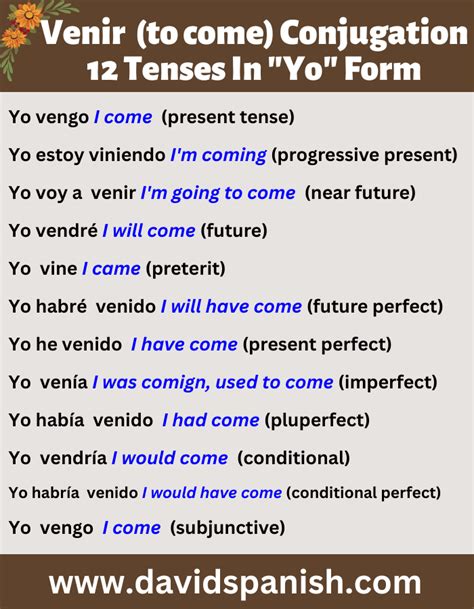Mastering the verb "venir" in Spanish can be a daunting task, especially for beginners. "Venir" is a highly irregular verb that has multiple forms and uses, making it challenging to understand and use correctly. However, with practice and the right guidance, you can master the 7 forms of "venir" in Spanish with ease.
Understanding the Verb "Venir"

The verb "venir" is a Spanish verb that means "to come" or "to arrive." It is an irregular verb, which means that it does not follow the usual conjugation patterns of other Spanish verbs. The verb "venir" has multiple forms and uses, including the present, preterite, imperfect, future, conditional, subjunctive, and imperative forms.
Why Mastering "Venir" is Important
Mastering the verb "venir" is essential for anyone learning Spanish. It is a commonly used verb that appears in many everyday conversations and expressions. By understanding the different forms and uses of "venir," you can improve your speaking, writing, and listening skills in Spanish.
The 7 Forms of "Venir" in Spanish

Here are the 7 forms of the verb "venir" in Spanish:
1. Present Form
The present form of "venir" is used to describe actions that are happening now or are true in general.
- Yo vengo (I come)
- Tú vienes (You come)
- Él/ella/usted viene (He/she/you come)
- Nosotros/as venimos (We come)
- Vosotros/as venís (You all come)
- Ellos/as vienen (They come)
2. Preterite Form
The preterite form of "venir" is used to describe completed actions in the past.
- Yo vine (I came)
- Tú viniste (You came)
- Él/ella/usted vino (He/she/you came)
- Nosotros/as vinimos (We came)
- Vosotros/as vinisteis (You all came)
- Ellos/as vinieron (They came)
3. Imperfect Form
The imperfect form of "venir" is used to describe ongoing or repeated actions in the past.
- Yo venía (I used to come)
- Tú venías (You used to come)
- Él/ella/usted venía (He/she/you used to come)
- Nosotros/as veníamos (We used to come)
- Vosotros/as veníais (You all used to come)
- Ellos/as venían (They used to come)
4. Future Form
The future form of "venir" is used to describe actions that will happen in the future.
- Yo vendré (I will come)
- Tú vendrás (You will come)
- Él/ella/usted vendrá (He/she/you will come)
- Nosotros/as vendremos (We will come)
- Vosotros/as vendréis (You all will come)
- Ellos/as vendrán (They will come)
5. Conditional Form
The conditional form of "venir" is used to describe hypothetical or uncertain situations.
- Yo vendría (I would come)
- Tú vendrías (You would come)
- Él/ella/usted vendría (He/she/you would come)
- Nosotros/as vendríamos (We would come)
- Vosotros/as vendríais (You all would come)
- Ellos/as vendrían (They would come)
6. Subjunctive Form
The subjunctive form of "venir" is used to express doubt, uncertainty, or possibility.
- Yo venga (I may come)
- Tú vengas (You may come)
- Él/ella/usted venga (He/she/you may come)
- Nosotros/as vengamos (We may come)
- Vosotros/as vengáis (You all may come)
- Ellos/as vengan (They may come)
7. Imperative Form
The imperative form of "venir" is used to give orders or commands.
- Ven (Come)
- Venid (Come, you all)
- Venga (Come, you)
- Vengan (Come, they)
Practical Examples and Exercises

Here are some practical examples and exercises to help you master the 7 forms of "venir" in Spanish:
- Present form: "Vengo a la fiesta esta noche" (I'm coming to the party tonight)
- Preterite form: "Vine a la fiesta ayer" (I came to the party yesterday)
- Imperfect form: "Venía a la fiesta todos los fines de semana" (I used to come to the party every weekend)
- Future form: "Vendré a la fiesta la próxima semana" (I will come to the party next week)
- Conditional form: "Vendría a la fiesta si tuviera tiempo" (I would come to the party if I had time)
- Subjunctive form: "Espero que vengas a la fiesta" (I hope you come to the party)
- Imperative form: "Ven a la fiesta" (Come to the party)
Exercises:
- Conjugate the verb "venir" in the present, preterite, and imperfect forms.
- Use the verb "venir" in a sentence to describe a past, present, or future action.
- Write a short paragraph using the verb "venir" in different forms and tenses.
Conclusion
Mastering the 7 forms of "venir" in Spanish takes time and practice, but with the right guidance and resources, you can improve your speaking, writing, and listening skills in Spanish. Remember to practice regularly and use the verb "venir" in context to reinforce your learning.
What is the verb "venir" in Spanish?
+The verb "venir" is a Spanish verb that means "to come" or "to arrive."
Why is mastering "venir" important in Spanish?
+Mastering "venir" is essential for anyone learning Spanish, as it is a commonly used verb that appears in many everyday conversations and expressions.
What are the 7 forms of "venir" in Spanish?
+The 7 forms of "venir" in Spanish are the present, preterite, imperfect, future, conditional, subjunctive, and imperative forms.
